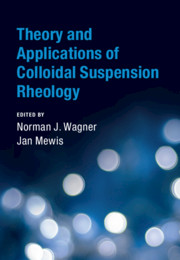Book contents
- Theory and Applications of Colloidal Suspension Rheology
- Cambridge Series in Chemical Engineering
- Theory and Applications of Colloidal Suspension Rheology
- Copyright page
- Dedication
- Contents
- Contributors
- Preface
- General List of Symbols
- Useful Physical Constants and Values
- 1 Introduction to Colloidal Suspension Rheology
- 2 Theory of Colloidal Suspension Structure, Dynamics, and Rheology
- 3 Methods of Colloidal Simulation
- 4 Microstructure under Flow
- 5 Rheology of Colloidal Glasses and Gels
- 6 Suspensions of Soft Colloidal Particles
- 7 Biocolloid Rheology
- 8 Hemorheology
- 9 Applications
- Index
- References
9 - Applications
Published online by Cambridge University Press: 07 April 2021
- Theory and Applications of Colloidal Suspension Rheology
- Cambridge Series in Chemical Engineering
- Theory and Applications of Colloidal Suspension Rheology
- Copyright page
- Dedication
- Contents
- Contributors
- Preface
- General List of Symbols
- Useful Physical Constants and Values
- 1 Introduction to Colloidal Suspension Rheology
- 2 Theory of Colloidal Suspension Structure, Dynamics, and Rheology
- 3 Methods of Colloidal Simulation
- 4 Microstructure under Flow
- 5 Rheology of Colloidal Glasses and Gels
- 6 Suspensions of Soft Colloidal Particles
- 7 Biocolloid Rheology
- 8 Hemorheology
- 9 Applications
- Index
- References
Summary
Some industrial products and processes involving colloid rheology are presented within the framework of this book. Paint rheology is presented and analyzed, where effects such as coating defects are avoided by ensuring the right rheology at each stage. Coating formulation is discussed, in particular for waterborne coatings. Carbon black suspensions are also widely used. Their microstructure is considered at different length scales. The resulting rheology includes time effects such as thixotropy. Measurement problems are reviewed as well as their electrical and dielectric behavior. For bitumen and asphalts, thermorheological behavior and aging are important and are controlled by their specific microstructure. A colloidal approach can also be used here. The rheology is discussed on the basis of the Roscoe model. For cement and cement-based products the rheology during shaping and hardening is linked to the underlying physical processes and interactions in the cement. Thixotropy and yield stress are relevant factors here. In the final part large scale processes are tackled. These often involve mixtures of large and small particles. Practical measurements such as the vane and the slump test are discussed, as well as the prediction of suspension behavior in industrial equipment. The compression behavior can be relevant here, including the compressive yield stress.
Information
- Type
- Chapter
- Information
- Theory and Applications of Colloidal Suspension Rheology , pp. 352 - 406Publisher: Cambridge University PressPrint publication year: 2021
References
Accessibility standard: Unknown
Why this information is here
This section outlines the accessibility features of this content - including support for screen readers, full keyboard navigation and high-contrast display options. This may not be relevant for you.Accessibility Information
- 4
- Cited by
